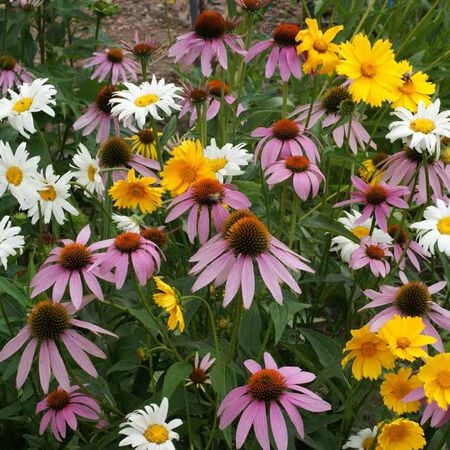Shade Flower Blend, Wildflower Seed
Key Attributes
Key Attributes
Product Details
Weight
0.07Depth
0.65Height
4.5Width
3.25Botanical Name
BlendSeed Type
SeedSow Depth
1/4"Breed
Open-pollinatedSun
Partial ShadeLife Cycle
PerennialSow Method
Direct SowCategories
FlowersDays To Maturity (# Days)
365Seeds Per Acre
5-10 lbsComponents
<ul> <li>18.51% Chinese Forget-Me-Not (Cynoglossum amabile)</li> <li>12.35% Annual Candytuft (Iberis umbellata)</li> <li>12.35% Baby Blue-Eyes (Nemophila menziesii)</li> <li>9.26% Lance Leaved Coreopsis (Coreopsis lanceolata)</li> <li>9.26% Purple Coneflower (Echinacea purpurea)</li> <li>9.09% Annual Baby's Breath ( Gypsophila elegans)</li> <li>6.17% Rocket Larkspur (Delphinium consolida)</li> <li>6.17% Mixed Corn Poppy (Papaver rhoeas)</li> <li>4.63% 'Alaska' Shasta Daisy (Chrysanthemum maximum)</li> <li>4.63% Sweet William Pinks (Dianthus barbatus)</li> <li>3.09% Tall Spurred 'Northern Lights' Snapdragon (Linaria maroccana)</li> <li>1.54% Johnny Jump-Up 'Helen Mount' (Viola cornuta)</li> <li>1.02 Clarkia (Calrkia unguiculata)</li> <li>0.77% Giant 'McKana Giants Mix' Columbine (Aquilegia caerulea)</li> <li>0.77% Dwarf Columbine (Aquilegia vulgaris)</li> <li>0.39% Tussock Bellflower (Campanula carpatica)</li> </ul> 99.04% Pure Seed, 79+11% Germination, 0.93% Inert Matter, 0.03% Weed SeedComponents
- 18.51% Chinese Forget-Me-Not (Cynoglossum amabile)
- 12.35% Annual Candytuft (Iberis umbellata)
- 12.35% Baby Blue-Eyes (Nemophila menziesii)
- 9.26% Lance Leaved Coreopsis (Coreopsis lanceolata)
- 9.26% Purple Coneflower (Echinacea purpurea)
- 9.09% Annual Baby's Breath ( Gypsophila elegans)
- 6.17% Rocket Larkspur (Delphinium consolida)
- 6.17% Mixed Corn Poppy (Papaver rhoeas)
- 4.63% 'Alaska' Shasta Daisy (Chrysanthemum maximum)
- 4.63% Sweet William Pinks (Dianthus barbatus)
- 3.09% Tall Spurred 'Northern Lights' Snapdragon (Linaria maroccana)
- 1.54% Johnny Jump-Up 'Helen Mount' (Viola cornuta)
- 1.02 Clarkia (Calrkia unguiculata)
- 0.77% Giant 'McKana Giants Mix' Columbine (Aquilegia caerulea)
- 0.77% Dwarf Columbine (Aquilegia vulgaris)
- 0.39% Tussock Bellflower (Campanula carpatica)
Growing Instructions
When to Plant:
For areas that tend to have little to no frost (Florida, Texas, California, etc..), wildflower can be planted all year round except in the dead of summer. For areas that get a hard, killing frost (Indiana, New York, Minnesota, etc..), wildflower should be planted in spring, summer and fall. Most wildflower mixes unless otherwise noted need at least 6 hours of sun to perform well. Full sun all day will give best results.
Preparing the Soil:
Remove all vegetation from the area where wildflower seed will be sowed. Remove any plants, till the soil and rake the area flat. If soil is a hard, no draining clay soil then compost should be added to help aid drainage.
Planting Wildflower:
Sand should be added to wildflower mixes that do not have filler already mixed in. Sand will help spread seeds better without clumps and can be seen better to aid in spreading. with sand for better visibilty and scatter the seeds directly on top of the soil. If you are sowing a larger area, we recommend using a seed spreader if not, you can sow by hand. After the seeds has been spread out they should be lighly compressing into the soil, making sure not to bury them but compressed enough so rain and wind will not move. You can either walk on them, use a board or if you are sowing a larger area, rent a seed roller.
Spreading Rate:
In general wildflower should be spread at 4-10 ounces per 1,000 sq.ft. or 4-15 lbs. per acre. Each wildflower mix should have exact details on spreading rate in the description. If not use the above rates.
Growing Wildflower:
It is important to keep the soil moist until the seedlings are about 4-6″ tall. After that, the seedlings will survive on natural rains. During dry weather the occasional watering will help. Do not let soil dry out while they are seedlings are this will kill the plants.
Caring for Wildflower:
Once a year the wildflower meadow should be mowed over. Wait until late fall when all the flowers have bloomed and dropped their seeds. Then with a weed trimmer, or a mower set on a tallest setting, mow over the entire meadow of wildflower. This will encourage strong growth in the spring without competing with dead old foliage.
Shipping Schedule
Our Seed Promise
 "Agriculture and seeds" provide the basis upon which our lives depend. We must protect this foundation as a safe and genetically stable source for future generations. For the benefit of all farmers, gardeners and consumers who want an alternative, we pledge that we do not knowingly buy or sell genetically engineered seeds or plants.
"Agriculture and seeds" provide the basis upon which our lives depend. We must protect this foundation as a safe and genetically stable source for future generations. For the benefit of all farmers, gardeners and consumers who want an alternative, we pledge that we do not knowingly buy or sell genetically engineered seeds or plants.
The mechanical transfer of genetic material outside of natural reproductive methods and between genera, families or kingdoms, poses great biological risks as well as economic, political, and cultural threats. We feel that genetically engineered varieties have been insufficiently tested prior to public release. More research and testing is necessary to further assess the potential risks of genetically engineered seeds. Further, we wish to support agricultural progress that leads to healthier soils, to genetically diverse agricultural ecosystems, and ultimately to healthy people and communities.
To learn more about the "Safe Seed Pledge" please visit www.councilforresponsiblegenetics.org.

